- Know information in brief on these
centres of learning. It covers who made them, what were they known for and who
destroyed them. Lastly, why do Indics take to education so naturally? 267 kms vikram,
odan puri 12kms bgaya 86 kms
Author and social worker Khemlata Wakhlu
wrote in A Kashmiri Century, “Schools were targeted and set ablaze. So was the school run by Rupa Devi Sharda Peeth Trust. With the burning of the school, some of the world's rarest books and manuscripts - in Pali, Persian, Hindi, Urdu and English all went up in smoke! The greatest treasure in Kashmir - the ideas and words of wise and erudite seekers over the ages - which had been kept in the premises of the school, were gone.” Pg 292
Centuries ago monasteries were destroyed
in Nalanda, Vikramshila, Odantapuri
also called Odantapura or Uddandapura (in what is now Bihar Sharif in Bihar) and
Valabi in Gujarat.
This compilation provides brief
information on these centres of learning. It covers who made the, what were
they known for and who destroyed them.
Bihar Universities Snapshot
|
University
|
Distance fm
Bodh Gaya
|
Period
Century
|
Destroyed by
|
|
1. Nalanda
|
86 kms
|
5-14th
|
B Khilji-See Article
|
|
2. Vikramsila
|
384 kms
|
8th to 13th
|
Bakhtiyar Khilji
|
|
3. Odantapuri
|
80 kms
|
8-13th
|
Bakhtiyar Khilji
|
While looking at these universities we must realize they existed and or peaked at different points of time even though their ending was by the Turks for e.g. Nalanda started declining from around the 7th century while Vikramsila came up in the 8th
century.
The
following is based on Volumes 3, 4, 5 of The History and Culture of the Indian People
published by the Bharatiya Vidya
Bhavan. The entire credit goes to the volume authors and editor. I have
only compiled.
1.
About Vikramashila
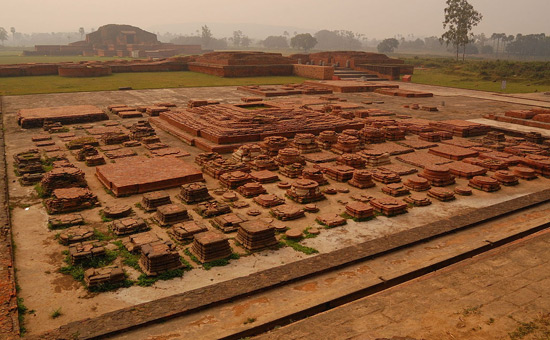
King Dharmapala (a Buddhist) is
remembered in Tibet because he was a great patron of Buddhism and founded the
Vikramasila monastery which was a centre of Buddhist learning and second only
to Nalanda. It was named after the great emperor who had a second name
Vikramasila and was located on the top of a hill, on the banks of the Ganga, in
Magadha. Most probably hill is near modern day Bhagalpur. 1 Pg 49 Period 750 to
1000 A.D.
It had 108 chambers. 108 monks (Panditas) were in charge of this monastic institution.
These Panditas and students were maintained by the state. This monastery
attracted students from Tibet and other foreign countries. It was here that
Sanskrit texts were translated into Tibetan. 1 Pg 272
Further, Vikramasila was an advanced
centre of learning like Nalanda and Valabhi in the 7th century a.d. “We also have sufficient evidence to prove that there existed at this Age organised educational institutions which were founded and maintained by the people from the king down to humble individuals.” So also “at Kanchipuram there lay to the east of Rajasimhesvara temple a college (kalluri) which is referred to in the inscriptions of Rajendra Chola I.” 1 Pg 369
Atisa or Dipankara (born 980 A.D.)
accepted the post of High Priest of Vikramasila at the request of king Nayapala.
1 Pg 448 He reformed Buddhism in
Tibet. To read about
Atisa
About 10 century A.D. Vikramasila became
a famous academic centre with its six renowned dvara-panditas, whose function was also to enter into a controversy
with the teachers of other religious faiths. 1 Pg 273
The Buddhist viharas attracted a lot of
students from Tibet. Vikramsila University was destroyed by Bakhtiyar Khilji
(General of Qutubuddin-Aibak) in the 12-13th century.
According to this Indian Express report, “Vikramshila was the only university that specialised in tantric and occult studies. In fact, during Dharmapala’s reign, Vikramshila reigned supreme and is known to have controlled Nalanda’s affairs as well,” said ASI Superintending Archaeologist (Patna Circle) Sujit Nayan.”
“At its peak, subjects such as theology, philosophy, grammar, metaphysics and logic were taught at Vikramshila. But the most important branch of learning were the tantras because Vikramshila flourished in the days of tantricism, when occult sciences and magic were subjects of study both in Buddhism as well as Hinduism.”
2. About Nalanda
University
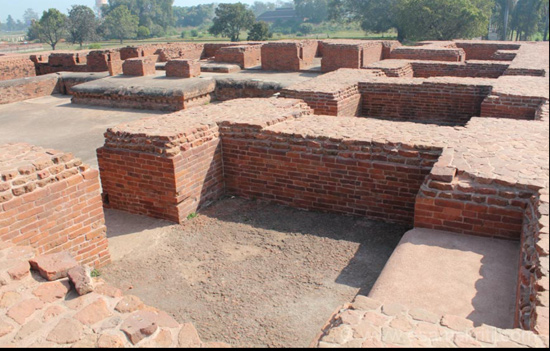 Monks
quarters.
Monks
quarters.
Nalanda was the place of birth of
Sariputra, one of the famous disciples of Buddha. As per the ASI board, Nalanda Mahavir was
founded by Kumaragupta (413-455 a.d.) of the great Gupta dynasty, Harshvardhana
of Kanauj (606-647) and the Pala Kings of East India (8-12th
century). Pala ruler Mahipala (988 A.D.) repaired the
Nalanda.
The
decline of the institution started in the later Pala period but the final blow
was by B Khilji around 1200. According to author Abhay K in the 13th
century 2 monasteries were operational but the institution was limping.
According to Volume 3, “The munificence of the Imperial Guptas in the cause of learning is proved by the foundation of a number of monasteries at Nalanda by a succession of rulers and princes of this line.” 3 Pg 352 (period
320-750).
Owing to its foundations to six successive generations of Gupta kings, it housed a population of several thousands who were maintained out of the revenues out of a hundred (or more) villages specially endowed for its upkeep.” 3 Pg 585 The only rival
Nalanda had as a centre of learning was Valabhi in Kathiawar, Gujarat. 3 Pg 586
According
to booklet that I bought from Nalanda, the university flourished between the
5-12th centuries. It housed about 10,000 students and 2,000
teachers. The courses of study included scriptures of Budddhism (both Mahayana
and Hinayana Schools), Vedas Logic, Grammar, Medicine etc. Nagarjuna, the
famous Mahayana philosopher, is said to have studied at Nalanda in 2nd century A.D. Hieun Tsang’s account says studied philosophy, logic, grammar, medicine and Atharvaveda at Nalanda. Sariputra’s Stupa, a few minutes from the main gate, is the most imposing structure.
In
930 A.D. Dharmadeva, a monk from Nalanda was received by the emperor of China
with great honors.
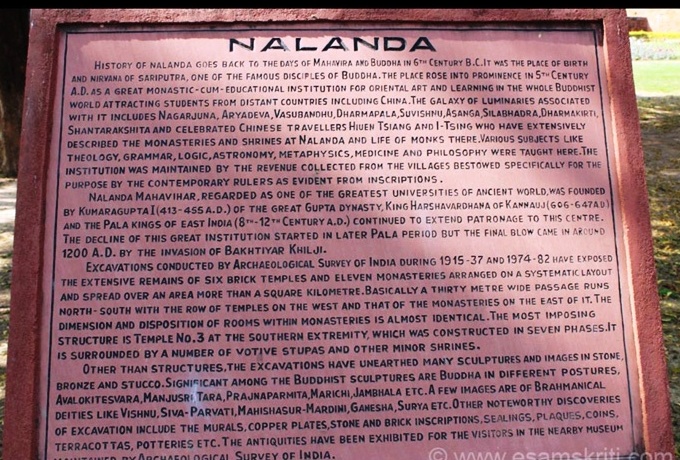 ASI board outside Nalanda says Bakhtiyar Khilji destroyed Nalanda around 1200.
ASI board outside Nalanda says Bakhtiyar Khilji destroyed Nalanda around 1200.
Was Nalanda destroyed by
Khilji?
The ASI board says it was destroyed by Khilji. However note, “Far more damaging to Nalanda than the fire (repaired by Mahipala I) was the rise of Vikramasila, which at this time surpassed Nalanda in fame and renown. Taranatha hints that the professional board of Vikramsila kept a watch over Nalanda’s affairs (see report below). Like Vikramsila, the University of Somapuri occupied a position of pre-eminence In Bengal since the days of Dharmapala.” 2 Pg 415 (period 1000-1300 A.D.) As I
said earlier, Nalanda started declining from the 7th century onwards
for a host of reasons i.e. beyond the scope of this article.
Contents of the preceding para are contrary to the common
narrative. So I first spoke to a senior professor in Bharatiya Vidya Bhavan
Delhi who said Nalanda was indeed destroyed by B Khilji. Thereafter, had a very
interesting chat with Abhay K author of Nalanda:
How it changed the world
According to him Bakhtyar Khilji destroyed Odantapura University i.e.
just 12 kms from Nalanda. The Turks destroyed Bodh Gaya i.e. 86 kms away from
Nalanda. Based on circumstantial evidence it is reasonable to say that Khilji
destroyed Nalanda. He wished to invade Tibet but failed to reach there.
To see album
of Nalana Ruins
Manik Roy wrote, “The first destruction was caused by the Huns under the reign of Mihirakula. The second destruction came during the 7th century by the Goudas. The third attack on the Nalanda University by the Turkish leader Bakhtiyar Khilji during the year 1193 was the most destructive and lethal which the Nalanda University could not bear its damages and ruined into the pieces as well. The total lifespan of Nalanda University was from 427 to 1197. Source
Why
is Nalanda is given much more importance than other universities?
There are various reasons. One it was close to Bodh Gaya 86 kms. Two, Nalanda is where one of Buddha’s foremost disciples Sariputra was born. Three, it was funded by about two hundred villages close by so was always well funded. Four, in its hey days it was like the Harvard University of its time. Five, royal patronage helped. Six, because of these reasons it attracted the best teachers and students from numerous countries.
3.
About Odantapura
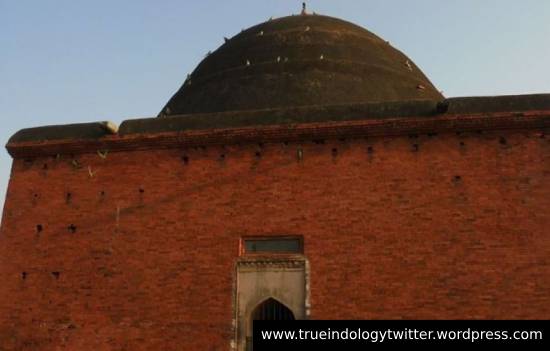 Dargah at University ruins.
Dargah at University ruins.
“It is said that during the reign of Gopala (Pala king of Bengal, a Buddhist) an upaska built the towering Odantapuri.” 1 Pg 270 Period 750 to 1000 A.D.
Bakhtyar
Khilji invaded Odantapuri (monastic University town in Bihar) around 1200 A.D.
Feeble resistance was offered by helpless shaven headed Buddhist monks whom
Bakhtyar mistook for Brahmin priests and slaughtered. 2 Pg 123
4. About Valabhi (in
Saurashtra, Gujarat)
Of
all the states that arose out of the ruins of the Gupta Empire Valabi (start
around 465 A.D.) was the most durable. It was established by the Maitraka
dynasty.
Valabhi
was an advanced centre of learning in the 7th century a.d. 1 Pg. 369
“The only rival to Nalanda as a centre of learning in India in the 7th century was Valabhi in Kathiawar. These were the two places in India where advanced students prepared to complete their education.” 3 Pg 586 (period 320-750)
“Grammar formed a major part of the course of studies in the 7th century a.d.
During the same period advances courses were provided in centres of learning
like Nalanad and Valahi. At Nalanda the course of studies comprised the 18
schools of Buddhism, but also the Vedas, logic, grammar, medicine, the Atharvavidya, the Sankhya etc.” 3 Pg 588
“In the 8th century, Arab invaders laid siege to Vallabhi, destroying its infrastructure and halting centuries of educational progress. Although the university struggled for a few hundred years with repairs, its glory days had long faded, and the center of learning was never fully revived.” Source N Here
Food
for thought
When in power or a position why do some destroy places of learning? Think.
What about Arabic numerals! “During the 8th and 9th centuries Indian became the teachers in arithmetic and algebra to the Arabs, and though them of the nations of the West. Thus, though we call the latter science by an Arabic name, it is a gift by India.” 1
Pg 451 Read Impact
of Hindu science on ancient and modern worlds
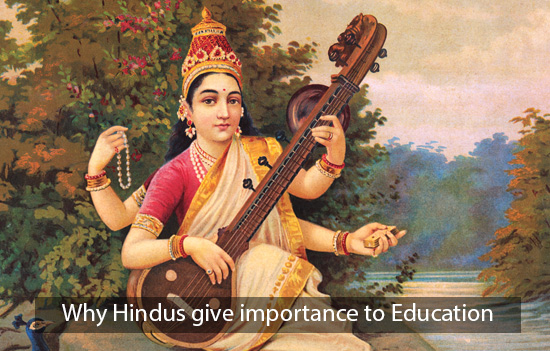 Why do Indics give so
much importance to education?
Why do Indics give so
much importance to education?
Kriyacharya
Jyoti wrote, “This thirst for knowledge has its roots deep in the ancient philosophy of this land and its people. The word Vidya is derived from the Sanskrit root Vid meaning to know, to perceive, to understand. Vidya means correct knowledge of the subject at hand and Vidyarthi is the student or scholar. Since ages the people of this land have been engaged in this 'seeking' of knowledge both internal and external.” To read full article
References
1.
The
History and Culture of the Indian People, Vol 4 (period750-1000 A.D.)
2.
The
History and Culture of the Indian People, Volume 5 (period 1000-1300).
3. The
History and Culture of the Indian People, Volume 3 (period 320-750).
Also
read
1. Another Bihar University set to rise from the ruins
2.
Five Indian
Universities destroyed by invasions
3.
Destruction of
Nalanda University
4. Did Khilji
destroy Nalanda
5. Nalanda.nic.in
6. About Valabhi
University, Gujarat
7. Famous
Universities of Ancient India
8. Odantapuri
university
9. To see Bodhgaya album